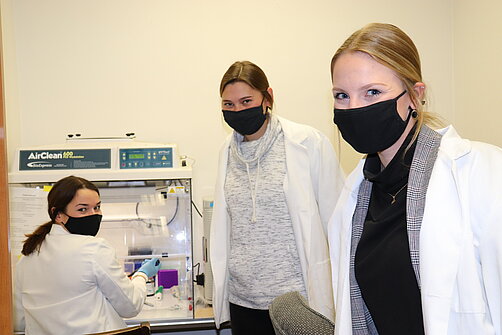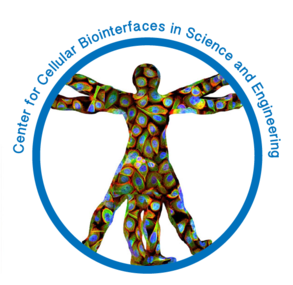The Center for Cellular Biointerfaces in Science and Engineering (CCBSE) is is supported by ND-ACES: New Discoveries in the Advanced Interface of Computation, Engineering, and Science, ND EPSCoR’s most recent NSF cooperative agreement (award number 1946202), and is a five-year cooperative agreement that carries an 80/20% federal/state cost sharing.
The ND-ACES Principal Investigator (PI) and Project Director (PD) is Colleen Fitzgerald, Ph.D.; NDSU. The Co-PI is Scott Snyder, Ph.D.; UND.
Publications
A list of reported peer-reviewed scholarly journals and papers in juried conference proceedings can be viewed at the NSF Public Access Repository (NSF-PAR)
Materials Design at Biointerfaces Pillar
The Materials Design at Biointerfaces Pillar objective is to progressively increase CCBSE researcher knowledge and application in the area of biomaterial scaffolds relevant to tissue engineering, particularly in the area of design methodologies of biologically inspired materials for diverse 3D tissue architectures. This pillar is co-led by Sanku Mallik (NDSU) and Julia Xiaojun Zhao (UND).
Cellular Systems at Materials Interface Pillar
The Cellular Systems at Materials Interface Pillar objective is to increase the capacity and expertise of the CCBSE researchers in basic and translational use of in vivo-like 3D cell cultures, which will ultimately (long-term outcome) allow the team to partner with regional health care providers to serve as a resource for personalized medicine approaches to cancer. This pillar is co-led by Archana Dhasarathy (UND) and John C. Wilkinson (NDSU).
Explain it to me - What is deep learning?
Integration with PROSPER (PROmoting Sustainable Partnerships in Education and Research)
PROSPER, the broadening participation arm of ND-ACES, provides education and experiences designed to build a diverse workforce, enhance partnerships and collaborations with various stakeholders, and inform North Dakota’s residents. The four elements of PROSPER are: Education and Workforce Development, Broadening Participation, Partnerships and Collaborations, and Comunication and Dissemination.
The goals of the CCBSE research efforts/intellectual merit are enhanced via the simultaneous and linked broader impact efforts of the PROSPER team and will be achieved through the establishment of diverse and sustainable STEM education and professional development pathways and expanded bioscience partnerships and internships designed to enhance success in future federal funding and support the transformation of research into practical use via trained personnel and new products. PROSPER will also expand underserved and underrepresented participation, and inform the residents of North Dakota.

Three ND-ACES Mayville State University undergraduate student researchers in the newly created Integrated Cell Culture and Bio-imaging Laboratory at Mayville State University.
Broadening Participation
Broadening Participation supports American Indian students and other underserved groups along the biosciences pathway. The STEM content conveyed in the activities of this element correlate to the CCBSE research areas and align with this team’s objective to increase the participation of underrepresented and underserved groups in STEM across a variety of age groups from elementary school to Ph.D. faculty.
Education and Workforce Development
Education and Workforce Development Element strengthens ND’s bioscience/STEM ecosystem by building a diverse pool of competitive researchers, skilled workers, effective educators, and engaged students. Working in close conjunction with the CCBSE, this element supports faculty professional development, student training, and K-12 student bioscience, engineering, and computational exposure.
Partnerships and Collaborations
The Partnerships and Collaborations team builds research infrastructure and strengthens ND’s research competitiveness through industry partnerships and other collaborations. The team works with CCBSE researchers and industry relations personnel to collaborate on research partnerships using established research protocols.
Communication and Dissemination
The Communcation and Dissemination team is working toward the goal of developing an elevated public understanding of the economic impact of growing North Dakota’s bioscience sector through strategic research investments as a result of data-sharing, communication, and outreach. Communication and Dissemintaion integrates with CCBSE researcher and PROSPER teams to create engaging content for public dissemination.
Acknowledgment
The ND-ACES NSF Track-1 cooperative agreement is a federal-state partnership to manage a comprehensive research development plan. ND EPSCoR manages the Track-1 award. Any opinions, findings, and conclusions or recommendations expressed in this material are those of the author(s) and do not necessarily reflect the views of the National Science Foundation. Current funding is provided by the State of North Dakota and NSF EPSCoR Research Infrastructure Improvement Program Track-1 (RII Track-1) Cooperative Agreement Award OIA #1946202.


